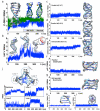Parmbsc1: a refined force field for DNA simulations
- PMID: 26569599
- PMCID: PMC4700514
- DOI: 10.1038/nmeth.3658
Parmbsc1: a refined force field for DNA simulations
Abstract
We present parmbsc1, a force field for DNA atomistic simulation, which has been parameterized from high-level quantum mechanical data and tested for nearly 100 systems (representing a total simulation time of ∼ 140 μs) covering most of DNA structural space. Parmbsc1 provides high-quality results in diverse systems. Parameters and trajectories are available at http://mmb.irbbarcelona.org/ParmBSC1/.
Figures



Similar articles
-
BIGNASim: a NoSQL database structure and analysis portal for nucleic acids simulation data.Nucleic Acids Res. 2016 Jan 4;44(D1):D272-8. doi: 10.1093/nar/gkv1301. Epub 2015 Nov 26. Nucleic Acids Res. 2016. PMID: 26612862 Free PMC article.
-
Modeling DNA Flexibility: Comparison of Force Fields from Atomistic to Multiscale Levels.J Phys Chem B. 2020 Jan 9;124(1):38-49. doi: 10.1021/acs.jpcb.9b09106. Epub 2019 Dec 28. J Phys Chem B. 2020. PMID: 31805230
-
All-atom molecular dynamics simulations of spin labelled double and single-strand DNA for EPR studies.Phys Chem Chem Phys. 2018 May 16;20(19):13461-13472. doi: 10.1039/c7cp08625c. Phys Chem Chem Phys. 2018. PMID: 29725672
-
Molecular dynamic simulations of environment and sequence dependent DNA conformations: the development of the BMS nucleic acid force field and comparison with experimental results.J Biomol Struct Dyn. 1998 Dec;16(3):487-509. doi: 10.1080/07391102.1998.10508265. J Biomol Struct Dyn. 1998. PMID: 10052609 Review.
-
Mixed Quantum Mechanical/Molecular Mechanical Molecular Dynamics Simulations of Biological Systems in Ground and Electronically Excited States.Chem Rev. 2015 Jun 24;115(12):6217-63. doi: 10.1021/cr500628b. Epub 2015 Apr 16. Chem Rev. 2015. PMID: 25880693 Review. No abstract available.
Cited by
-
Site-specific investigation of DNA Holliday Junction dynamics and structure with 6-Methylisoxanthopterin, a fluorescent guanine analog.Trends Photochem Photobiol. 2023;22:85-102. Trends Photochem Photobiol. 2023. PMID: 39371247 Free PMC article.
-
A new paradigm for molecular dynamics databases: the COVID-19 database, the legacy of a titanic community effort.Nucleic Acids Res. 2024 Jan 5;52(D1):D393-D403. doi: 10.1093/nar/gkad991. Nucleic Acids Res. 2024. PMID: 37953362 Free PMC article.
-
Novel inhibitors of the main protease enzyme of SARS-CoV-2 identified via molecular dynamics simulation-guided in vitro assay.Bioorg Chem. 2021 Jun;111:104862. doi: 10.1016/j.bioorg.2021.104862. Epub 2021 Mar 29. Bioorg Chem. 2021. PMID: 33862474 Free PMC article.
-
OCT4 interprets and enhances nucleosome flexibility.Nucleic Acids Res. 2022 Oct 14;50(18):10311-10327. doi: 10.1093/nar/gkac755. Nucleic Acids Res. 2022. PMID: 36130732 Free PMC article.
-
Unfolding rates of 1:1 and 2:1 complex of CX-5461 and c-MYC promoter G-quadruplexes revealed by single-molecule force spectroscopy.Biophys Rep. 2024 Jun 30;10(3):180-189. doi: 10.52601/bpr.2024.240018. Biophys Rep. 2024. PMID: 39027314 Free PMC article.
References
Online Methods references
-
- Krishnan R, Binkley JS, Seeger R, Pople JA. J. Chem. Phys. 1980;72:650–654.
-
- Woon DE, Dunning TH., Jr J. Chem. Phys. 1993;98:1358–1371.
-
- Becke AD. J. Chem. Phys. 1993;98:5648–5652.
-
- Head–Gordon M, Pople JA, Frisch MJ. Chemical Physics Letters. 1988;153:503–506.
-
- Halkier A, Helgaker T, Jørgensen P, Klopper W, Olsen J. Chem. Phys. Lett. 1999;302:437–446.
Publication types
MeSH terms
Substances
Grants and funding
LinkOut - more resources
Full Text Sources
Other Literature Sources

